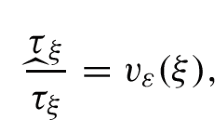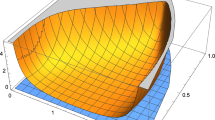Abstract
In evolution equations for a complex amplitude, the equation for the phase is much more intricate than for the amplitude. Nevertheless, general methods should be applicable to both variables. In the example of the traveling-wave reduction of the complex cubic-quintic Ginzburg-Landau (CGL5) equation, we explain how to overcome the difficulties arising in two methods: (1) the criterion that the sum of residues of an elliptic solution is zero and (2) the construction of a first-order differential equation admitting a given equation as a differential consequence (subequation method).
Similar content being viewed by others
References
I. S. Aranson and L. Kramer, Rev. Modern Phys., 74, 99–143 (2002); arXiv:cond-mat/0106115v1 (2001).
W. van Saarloos, Phys. Rep., 386, 29–222 (2003); arXiv:cond-mat/0308540v2 (2003).
A. V. Klyachkin, “Modulational instability and autowaves in the active media described by the nonlinear equations of Ginzburg-Landau type,” Preprint No. 1338, Ioffe Phys. Tech. Inst., Leningrad (1989).
M. Musette and R. Conte, Phys. D, 181, 70–79 (2003); arXiv:nlin.PS/0302051v1 (2003).
R. Conte and M. Musette, The Painlevé Handbook, Springer, Berlin (2008).
R. Conte and M. Musette, Stud. Appl. Math., 123, 63–81 (2009); arXiv:0903.2009v1 [math.CA] (2009).
J. Chazy, Acta Math., 34, 317–385 (1911).
P. Marcq, H. Chaté, and R. Conte, Phys. D, 73, 305–317 (1994); arXiv:patt-sol/9310004v1 (1993).
A. N. W. Hone, Phys. D, 205, 292–306 (2005).
S. Yu. Vernov, J. Phys. A, 40, 9833–9844 (2007); arXiv:nlin/0602060v2 (2006).
C. Briot and J.-C. Bouquet, Théorie des fonctions elliptiques (1st ed.), Mallet-Bachelier, Paris (1859); Gauthier-Villars, Paris (1875).
R. Conte and T. W. Ng, “Meromorphic traveling wave solutions of the complex cubic-quintic Ginzburg-Landau equation,” Acta Appl. Math. (in press 2012).
G.-H. Halphen, Traité des fonctions elliptiques et de leurs applications (http://gallica.bnf.fr/document?O=N007348), Gauthier-Villars, Paris (1890).
S. Popp, O. Stiller, I. Aranson, and L. Kramer, Phys. D, 84, 398–423 (1995).
H. Chaté, Nonlinearity, 7, 185–204 (1994).
J. Swift and P. C. Hohenberg, Phys. Rev. A, 15, 319–328 (1977).
Author information
Authors and Affiliations
Corresponding author
Additional information
Prepared from an English manuscript submitted by the authors; for the Russian version, see Teoreticheskaya i Matematicheskaya Fizika, Vol. 172, No. 2, pp. 224–235, August, 2012.
Rights and permissions
About this article
Cite this article
Conte, R., Ng, TW. Detection and construction of an elliptic solution of the complex cubic-quintic Ginzburg-Landau equation. Theor Math Phys 172, 1073–1084 (2012). https://doi.org/10.1007/s11232-012-0096-4
Published:
Issue Date:
DOI: https://doi.org/10.1007/s11232-012-0096-4




